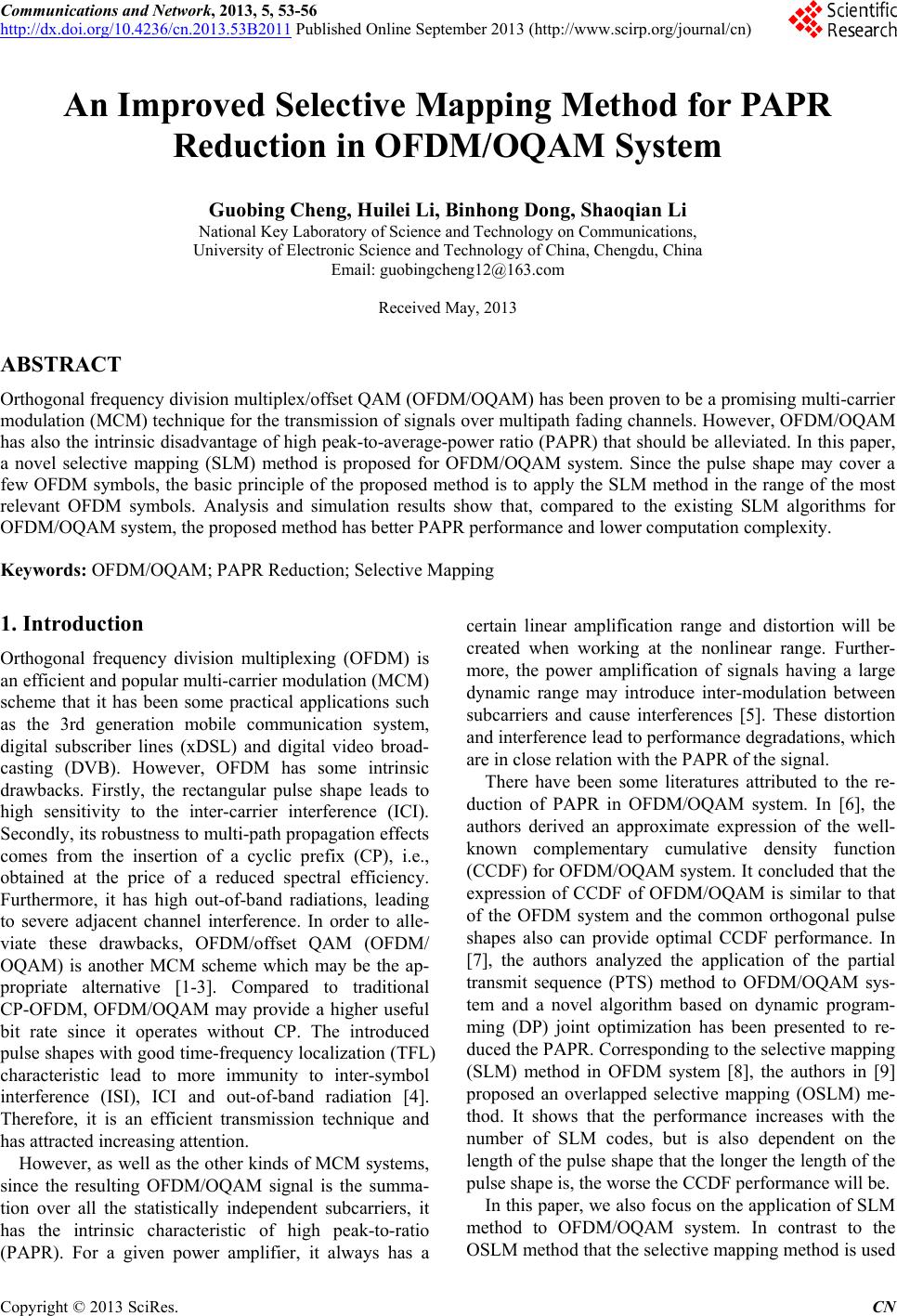
Communications and Network, 2013, 5, 53-56
http://dx.doi.org/10.4236/cn.2013.53B2011 Published Online September 2013 (http://www.scirp.org/journal/cn)
An Improved Selective Mapping Method for PAPR
Reduction in OFDM/OQAM System
Guobing Cheng, Huilei Li, Binhong Dong, Shaoqian Li
National Key Laboratory of Science and Technology on Communications,
University of Electronic Science and Technology of China, Chengdu, China
Email: guobingcheng12@163.com
Received May, 2013
ABSTRACT
Orthogonal frequency division multiplex/offset QAM (OFDM/OQAM) has been proven to be a promising multi-carrier
modulation (MCM) technique for the transmission of signals over multipath fading channels. However, OFDM/OQAM
has also the intrinsic disadvantage of high peak-to-average-power ratio (PAPR) that should be alleviated. In this paper,
a novel selective mapping (SLM) method is proposed for OFDM/OQAM system. Since the pulse shape may cover a
few OFDM symbols, the basic principle of the proposed method is to apply the SLM method in the range of the most
relevant OFDM symbols. Analysis and simulation results show that, compared to the existing SLM algorithms for
OFDM/OQAM system, the proposed method has better PAPR performance and lower computation complexity.
Keywords: OFDM/OQAM; PAPR Reduction; Selective Mapping
1. Introduction
Orthogonal frequency division multiplexing (OFDM) is
an efficient and popular multi-carrier modulation (MCM)
scheme that it has been some practical applications such
as the 3rd generation mobile communication system,
digital subscriber lines (xDSL) and digital video broad-
casting (DVB). However, OFDM has some intrinsic
drawbacks. Firstly, the rectangular pulse shape leads to
high sensitivity to the inter-carrier interference (ICI).
Secondly, its robustness to multi-path pro pagatio n effects
comes from the insertion of a cyclic prefix (CP), i.e.,
obtained at the price of a reduced spectral efficiency.
Furthermore, it has high out-of-band radiations, leading
to severe adjacent channel interference. In order to alle-
viate these drawbacks, OFDM/offset QAM (OFDM/
OQAM) is another MCM scheme which may be the ap-
propriate alternative [1-3]. Compared to traditional
CP-OFDM, OFDM/OQAM may provide a higher useful
bit rate since it operates without CP. The introduced
pulse shapes with good time-frequency localization (TFL)
characteristic lead to more immunity to inter-symbol
interference (ISI), ICI and out-of-band radiation [4].
Therefore, it is an efficient transmission technique and
has attracted increasing attention.
However, as well as the other kinds of MCM systems,
since the resulting OFDM/OQAM signal is the summa-
tion over all the statistically independent subcarriers, it
has the intrinsic characteristic of high peak-to-ratio
(PAPR). For a given power amplifier, it always has a
certain linear amplification range and distortion will be
created when working at the nonlinear range. Further-
more, the power amplification of signals having a large
dynamic range may introduce inter-modulation between
subcarriers and cause interferences [5]. These distortion
and interference lead to performance degradations, which
are in close relation with the PAPR of the signal.
There have been some literatures attributed to the re-
duction of PAPR in OFDM/OQAM system. In [6], the
authors derived an approximate expression of the well-
known complementary cumulative density function
(CCDF) for OFDM/OQAM system. It concluded that the
expression of CCDF of OFDM/OQAM is similar to that
of the OFDM system and the common orthogonal pulse
shapes also can provide optimal CCDF performance. In
[7], the authors analyzed the application of the partial
transmit sequence (PTS) method to OFDM/OQAM sys-
tem and a novel algorithm based on dynamic program-
ming (DP) joint optimization has been presented to re-
duced the PA PR. Co rr espo nd in g to the selective mapping
(SLM) method in OFDM system [8], the authors in [9]
proposed an overlapped selective mapping (OSLM) me-
thod. It shows that the performance increases with the
number of SLM codes, but is also dependent on the
length of the pulse shape th at the longer the length of the
pulse shape is, the worse the CCDF performance will be.
In this paper, we also focus on the application of SLM
method to OFDM/OQAM system. In contrast to the
OSLM method that the selective mapping method is used
C
opyright © 2013 SciRes. CN